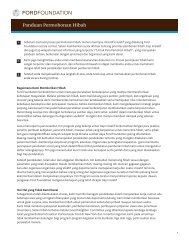Globalization, Health Sector Reform, Gender and ... - Ford Foundation
Globalization, Health Sector Reform, Gender and ... - Ford Foundation
Globalization, Health Sector Reform, Gender and ... - Ford Foundation
- No tags were found...
You also want an ePaper? Increase the reach of your titles
YUMPU automatically turns print PDFs into web optimized ePapers that Google loves.
Core Components of <strong>Sector</strong> Program AssistanceThe components of sector program assistance are agreed through extensive negotiations among donorsthemselves <strong>and</strong> between the recipient government <strong>and</strong> the donor consortium. These core componentsare summarized below:• Donor assistance <strong>and</strong> ministry finance are pooled into one coordinated sector program rather thana series of separate donor projects.• A sector-wide strategy is formulated <strong>and</strong> implemented by the Ministry of <strong>Health</strong> on the basis ofextensive consultation between ministry officials, all donor partners <strong>and</strong> stakeholders.• A common budget <strong>and</strong> accounting framework, common procurement arrangements <strong>and</strong> joint reviewprocedures for sector program activities are established.• Local capacity in the management <strong>and</strong> delivery of health services is strengthened.• Government sets up systems to ensure more effective <strong>and</strong> accountable resource utilization.Most countries undergoing SWAPs have a history of structuraladjustment where cuts in the public sector deficit have been acentral feature. A common starting point, therefore, for manySWAPs <strong>and</strong> the associated health sector reforms (HSR) is “tight”or constrained public-sector financing. This partly explains theemphasis within HSR on developing alternative sources of finance<strong>and</strong> streamlining the sector to provide “basic,” “essential” or “core”services to meet the needs of the poor <strong>and</strong> vulnerable. Withoutimprovements in quality <strong>and</strong> patterns of service delivery, cuts inhealth expenditure are unlikely to strengthen women’s reproductivehealth—especially where public-sector interventions havebeen shown to have a positive impact. However, in view of thepoor targeting of health expenditure in the past, one cannot saywith certainty that a decline in health expenditure will necessarilyresult in worse health outcomes. For instance, if cuts in expenditureby the Ministry of <strong>Health</strong> are accompanied by an increase (orbetter targeting) in investment in sanitation, particularly cleanwater, <strong>and</strong> this results in increased access to clean water amongthe poor, the outcome for women’s reproductive health may actuallyimprove.In many ways SWAPs are a “continuation of several elements of theclassic HSR agenda, notably reforming health management systems<strong>and</strong> ministries of health <strong>and</strong> setting clear priorities for the publicsector” (St<strong>and</strong>ing, H., 1999). However, certain aspects of sectorwideprograms represent efforts to learn from past mistakes. Forinstance, the strong emphasis on government ownership representsthe attempt to avoid the pitfalls of “conditionality” associated with20
















